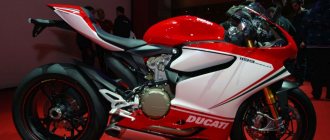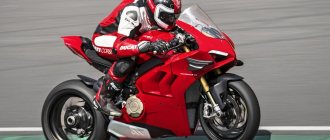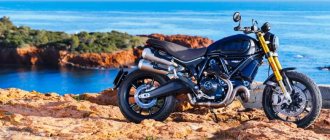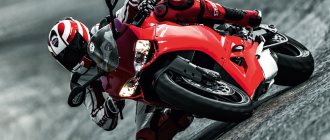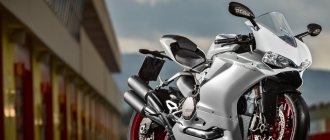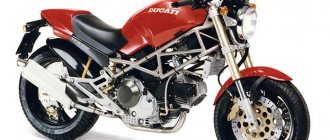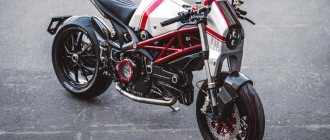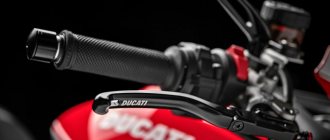Ducati Panigale 959 2016-2018
In 2021, Ducati shook up the supersport market with its “almost liter” Panigale 959. It is impossible not to agree that this model was a success, and it is not surprising that the Reds decided to continue its production, bringing it almost entirely into 2021.
Its engine is expectedly powerful, and a set of assistance and safety systems allows you to keep this power in check, making the “959” quite friendly for a sportbike. Motorcycle racing fans find many reasons to be excited about this model, and the owners are deservedly proud of it, because in addition to its sporty appearance, the Panigale is very seriously equipped. But can it successfully compete with new products in its densely populated segment?
Ducati Panigale 959 design
The recognizable appearance of the Ducati Panigale 959 begins with the characteristic frowning “muzzle” in the form of an “angry bird”. The wind tunnel-tested skin expands from the nose rearwards to enclose almost the entire powerplant. It has two large ventilation windows that remove hot air from the radiators, and, fortunately, not to the rider’s feet.
To drive on the roads you need mirrors and turn signals, and the manufacturer took care of this by making it a two-in-one. This is a very good solution in the sense that the front fairing does not contain unnecessary elements; moreover, high-mounted turn signals are better visible to other road users, and this adds safety.
Ducati Panigale 959 Red
The transparent windshield makes a very small hole in the oncoming air flow, but don’t worry, everything is calculated correctly: clip-ons and rear-mounted footpegs leave no other seating options than a deeply sporty one. The wide 17-liter tank has comfortable indentations for the knees, and the narrow seat allows you to comfortably “lower the chassis” during stops and actively hang down during aggressive riding.
A low nose and high tail is the sportbike silhouette that's trending these days, and the Panigale strictly follows the trend with a raised subframe that lifts your brave passenger and creates a small step to prevent the sportbike from slipping out from under the rider. As for the seat itself, its passenger part clearly hints that it was made “for the sake of it,” and not for the comfort of the plus one.
The tail section tapers into a minimal mudguard, which is also a license plate holder and mount for narrow and high-mounted turn signals. In general, the rear part continues the minimalistic design of the front, and throughout the Panigale its sporty essence is felt: no part of the motorcycle will prevent you from sawing off the sliders on your overalls, if you have enough gunpowder for it.
Ducati Panigale 959 review
And this 969 must be simply magnificent, because just yesterday Ducati released the 899, a motorcycle that, in my humble opinion, is the most sophisticated everyday sports bike Ducati has ever produced.
There's something about Ducati's mid-engined sports bikes, starting with the 748, that tugs at my heartstrings.
I once took part in a group test of used motorcycles. The three of us each chose a motorcycle with an expected cost in the middle price range. I've never been able to make James laugh as hard as I did when I took the cover off a tired 748 import that had never seen a fork seal or a can of chain lube in its entire life.
He didn't turn, he didn't want to stop and he barely moved. But I didn't care. It was a 748, and if I had to pay real money to play with it, I would still have it, all rusty.
When I got the editorial job and had to choose a bike for long-term testing across the country, it was already a shiny red 848 EVO, and I pretended I picked it at random.
Don't get me wrong, I loved the 1299 almost as much as I loved the 1198. They really are as stunning as you'd expect, and maybe even better. But to be honest, I'm not good enough to fully appreciate the big Panigale's potential on the track. And what is not noticeable on the track is even more lost on the road, which is why I like Ducati superbikes with a smaller engine capacity more.
This 959 must be absolutely stunning, as just yesterday Ducati released the 899, a bike that is, in my humble opinion, the most complete everyday sports bike Ducati has ever produced.
Let's get down to business
But it doesn't bother me. In fact, I quite liked this new bike, even if it's straight from the warehouse.
It would be interesting to see how many people start trumpeting their displeasure when a new motorcycle is posted. I think if you're looking for a bike that costs over £13,000, you're certainly smart enough to realize that you're being offered the chance to swap a stock bike for something you like better. This machine is Euro 4 compliant and is where the VAG family of Ducati motorcycles began. I'm pretty sure they must want to have no problems when it comes to complying with current regulations. The 959's exhaust pipes are larger than the 899's. In fact, they have the exact same 60mm diameter as the 1299's, so aftermarket exhaust pipes that fit the 1299 will also fit here. .
This is simple, let's move on to other points.
The heart of the new Panigale is the 955 cm3 Superquadro engine. Increased piston stroke, new crankshaft, new pistons and additional injectors all combine to produce 157 hp. effective power at 10,500 rpm. Torque is increased by 8% to 107.4 Nm. Although Euro 4 intrigues have forced a slight weight increase over the 899, the 200kg battle-ready 959 Panigale has a power-to-weight ratio two percent higher than the old model and a torque-to-weight ratio two percent higher than the old model. His weight increased by 4 percent.
Impressive driver software package
Quickshifter, traction control, servo throttle and a variety of ride patterns allow any rider to find the personal settings that best suit their riding style as they strive to reach the horizon. A slipper clutch, ABS with different settings and engine-assisted braking control will keep you from falling off the edge of the world when you reach it.
Externally, the motorcycle creates a feeling of real evolution
It is wider in front and taller. The new width accommodates a new air intake system, while the taller windshield improves air flow around the driver and reduces drag. The mirrors are also new, as is the rear, which now consists of two elements. The exception is the wheel design (which I never liked). Now I really like the look of the bike. Even with its exhaust system and two-way rocker arm. The angle of this rocker arm is 4mm lower than the 889's, and the overall wheelbase of the bike has increased by 5mm.
The dashboard layout is logical and easy to read
The dashboard supports both DDA and GPS, allowing the rider to get graphs of the motorcycle's performance after spirited shopping trips from the comfort of his own laptop. Having gone through the various riding modes and made the necessary settings, you will see that the motorcycle is as easy to adapt to yourself as it is for me to write about it.
Of course, I've been very lucky to have had the opportunity to spend a lot of time on a variety of Ducati motorcycles, so I can easily find my way into all of these setups. If this is your first time encountering this brand, then at first you may find it difficult, but everything is relatively intuitive, and searching for modes and settings is not irritating.
Finished in Arctic White, the 959 Panigale resembles a beefy 899. I saw it with my own eyes in red, and the puritan in me prefers red to white every time. Just like the racing Yamaha is yellow and the GSX-R is blue and white, the Ducati just has to be red. Strangely, the red version is the cheaper of the two offerings, selling for $17,095. And if you want the bike painted white, you'll need to find another £200.
We tested the 959 Panigale at the Circuito Ricardo Tormo near Valencia. The final MotoGP race of this year is held here. For me, it is more important that the first generation Tuono V4 motorcycle appeared here four years ago. So I have some idea of how the first turn is marked. This is a beautiful trek, but it is physically demanding. There are nine left turns, and some of them are done at 100 mph (160 km/h) with your knee to the ground. And you only have to turn right four times. The Pirelli Diablo Supercorsa SC2 tires we used here were glueable right from the start. During the first pass of the track the air temperature was about 14°, and by the last lap it rose to 20°. The wind was gusty and the sky was clear. I consider these ideal conditions for track racing.
Exciting first attempt
Instead of taking my own advice and devoting the first lap to getting to grips with the new bike, I decided to go as fast as I dared within a few corners of the pit area. I'm usually one of those riders who is quite calm early in the morning and let the track get used to me. But since I've driven here before and really enjoyed it, I wanted to give it a try and get it to a respectable speed sooner rather than later.
I spent some time adjusting the front brake lever to fit my ridiculously short fingers, and was still getting used to the feel of the brakes as I hit the long straightaway for the first time. I drove past the pits in fifth gear, reminiscing about the good old days, then my spirits soared and, instead of shifting from first to third gear as planned, I pulled at the limit allowed by the electronics. It’s impossible to say that my heart almost jumped out of fear, because I knew that I was forcing myself to go faster than usual, but I left my (very comfortable) comfort zone.
I had to return to the line like a beaten dog.
On this first attempt the bike was in Sport mode. This mode is essentially intended for road driving, providing traction control and the use of ABS. The electronic intervention was almost imperceptible, but to cope with the motorcycle in this mode required great physical effort. The ABS kept activating, forcing me off the line I wanted to stay on. It was disconcerting, pushing me far out of corners, so the ride became a serious physical exercise. When riding in a straight line, I didn't get a single disapproving head shake, as I did with the more powerful Panigales engine with almost linear power delivery. I just didn't fit the bike and thought it would be better to spend the day at the office. The 959 changed direction beautifully, with right and left turns on the long final corner as easy as if I'd entered the corner in second gear and quickly shifted into third. But everything was done at third speed.
Even though the bike was in Sport mode, the engine didn't feel like it wanted to go straight from slow to third gear. The instinct of self-preservation made me take those few right turns at almost walking speed, and just imagined how little work this side of the tire was doing, and how easy it was to lose everything. It's a shame to write about this, but what I mean is that I was twisting the throttle to a stop while coming out of them, and more than once it felt like the bike was trying to tie itself up.
As my speed in right turns increased, I found myself unable to appreciate the difference between second and third gear, sometimes finding myself limiting myself to second gear on short straights rather than shifting to extra power and then returning to second speed for the next turn. Once again, when determining which gear to select for specific sections of the trail, I ended up spending more time either at the top of one gear, which showed the purity and usability of the bike's power, or at the bottom of another gear, emphasizing how useful the torque available was. . It doesn't matter if you think that a 955cc motorcycle is too big to play the role of a little brother. In any case, the practicality of this engine doesn't even come into question, and I have little doubt that it will perform as well on the road as it did on the track.
After the first run, we switched the bike to Race mode
Subdued traction control, less ABS work, and more aggressive power delivery make this bike much more balanced with itself. The brakes feel much better on corner entry, working nicely with the slipper clutch and allowing me to concentrate on getting to the apex of the corner and exiting it. Corner exit was better as the bike felt more inclined to run at higher revs. This mode and these settings made the bike less heavy to ride, and I was moving much faster than in the first run, and nowhere was I required to work as hard on my muscles.
I tried to brake later than before coming off the track and had absolutely no problem pressing my knee into the paint while turning. If there is a lesson to be learned here, I would say it has to do with comfort zones and taking the time to expand them. I'm glad I went through with it as I was able to find better bike setups. If you decide to buy a 959, be sure to set the ride modes to suit what you're doing, and don't be afraid to turn off the assistance systems when you're on the track. The rewards for this are obvious, and you won't need to put in much physical effort.
The taller windshield and slightly wider fairing felt ideal for racing, easily coming into play at the start of a straight line, and I could concentrate on getting each speed to its maximum level before changing to another speed using the smooth quickshifter. I also think the aerodynamic improvements will make long freeway trips easier on the upper half of your body. The pegs on this bike are from a Superleggera and they are simply beautiful. They work very well and still look quite thick. If this were my bike, I'd give the fuel tank a rougher feel with Stomp grips decals, and I'd love it if I could lean on the brakes a little more with my feet. By the end of each race, my arms felt like they had come out of a serious workout. I am sure that if some of my weight were transferred to my legs, this sensation would be lessened.
Each run presented a chance to go a little further here and there
Whereas at the start of the day I was already limited to second gear within a second, I now found myself diving into third gear as the beefed-up engine was now much easier to control thanks to improved feel and faith in the brakes. This bike is fast. We're going to try options with different accessories, and just the base trim - to be honest, those pipes that everyone but me seems to hate sound pretty track-appropriate to me.
The excellent and uninterrupted (from the traction control) transition from the bottom of second gear through the corner to driving through the paint was a testament to the quality of the fuel delivery and the assistance from the electronics and tires. The transition from the throttle to the brakes was easy, and the brake response felt perfectly tuned.
What I said at the beginning about the Panigale's size being better suited to my track racing talents than its big brother still applies. This bike is not slow by any means, it just doesn't feel as ferocious as the 1299 and that suits me just fine. Ducati's best-selling models were the 848 and 899. This version of the 959 deserves just as much attention, and will reward you with an experience as exciting as every part of the bike. Some may still consider this model a little brother, but this bike has energy to grow and new muscles to relax.
Ducati Panigale 959 chassis
The front fairing is more than just a pretty face. It's a load-bearing structure made of sheet aluminum - like the Vesps at the top of the food chain. The engine is also a load-bearing element, completing the structure with a pair of aluminum washers that act as a steering column and steering damper, softening the occasional kickback. The steering angle is 24 degrees, the trail is 96 mm, the wheelbase is 1430 mm, and all this together makes the Panigale very agile.
Part of this agility is achieved thanks to the motorcycle's low dry weight of 175 kg , and this is facilitated by the monocoque frame, simultaneously solving a number of other problems. Hot fuel is a weak fuel, and heating the gas tank against the engine becomes a problem, but Ducati solved this by forming an airbox out of the fairing, which is placed between the tank and the engine, thereby preventing heat from transferring from the engine to the tank.
The Showa Big Piston fork controls the behavior of the front, and the rear vibrations are smoothed out by the Showa suspension. Both suspensions are fully customizable. The aluminum hollow swingarm reduces both overall and unsprung weight. Alloy 17-inch wheels are shod with Pirelli Diablo Rosso Corsa measuring 120/70 at the front and 180/60 at the rear.
The Brembo braking system consists of two 320 discs and monoblock four-piston calipers at the front, and one 245 disc with a single two-piston caliper at the rear. To this is added ABS from Bosch as the first safety loop.
Ducati Panigale 959 Arctic White Silk
Engine Ducati Panigale 959
The remaining safety circuits are subordinated to the engine control department. The fully electronic throttle works in conjunction with the engine braking control function, complemented by several riding modes that affect engine power, and the set of safety systems is completed by Ducati's eight-level traction control.
A similar array of safety features is highly desirable to have on a motorcycle of this power. The two-cylinder L-shape Superquadro, so named for its four valves per cylinder, produces 150 horses at 10,500 rpm, and 101.7 Nm at 9,000 rpm. And believe me, for such a light motorcycle this is a LOT. The desmodromic timing mechanism drives the valves in both directions using cams, without the use of springs, and thereby prevents the valves from sticking at high speeds.
Power is sent to the rear wheel through a six-speed gearbox equipped with Ducati's DQS quickshifter. DQS provides shifting without squeezing the clutch handle, at the press of a button, coupled with a slipper clutch that prevents the rear wheel from slipping by limiting reverse torque from the engine.
The engine has massive short-stroke pistons with a diameter of 100 mm and a stroke of 60.8 mm with a total volume of 955 cc. cm and a fairly high compression ratio - 12.5:1, and complies with Euro 4 econorms. The cooling system is liquid.
REVIEW – DUCATI 959 Panigale and 959 Panigale Corse – racing bikes among us
The DUCATI 959 Panigale Corse is the best sporting achievement in the history of the famous two-cylinder engine from Borgo Panigale. Thanks to modern technical equipment and a special MotoGP livery, the 959 Panigale Corse not only attracts the attention of others with its appearance, but also demonstrates excellent results on the race track.
To understand what this superbike can do, just go out on the track and time a lap with a stopwatch. At the same time, it is very important for the manufacturer from Bologna to create perfect motorcycles that can be used not only in racing, but also in urban conditions.
The Borgo Panigale plant uses innovative technologies, high-quality materials and progressive ideas in its work. It was thanks to this approach that it became possible to create unique motorcycles. With the spirit of winning superbikes and racing prototypes, the 959 Panigale is perfect for everyday use - a combination that no other bike can achieve.
Differences between the 959 Panigale Corse and the base 959 Panigale
The equipment of the DUCATI 959 Panigale Corse is distinguished by the presence of a lithium battery, a steering damper from Öhlins, and titanium DUCATI Performance mufflers manufactured by Akrapovic.
Another feature of the DUCATI 959 Panigale Corse is the new livery. The bright style of the motorcycle is emphasized by a two-tone color: white mixed with matte classic DUCATI red. This color scheme is reminiscent of the Desmosedici MotoGP colors and makes the bike recognizable.
In addition, the 959 Panigale Corse receives premium suspension from Öhlins. The Öhlins NIX30 fork has a diameter of 43 mm and several adjustments. The fork legs are covered with a hard-to-wear TiN layer, which protects them from wear and significantly extends the service life of the structural element. The Öhlins TTX36 rear shock boasts numerous settings. The front and rear suspension kits are complemented by a steering shock absorber, also from Öhlins, which has all the necessary adjustments.
Perfect balance
One of the distinctive features of the DUCATI 959 Panigale is the impeccable balance of power and lightness. Despite the high performance, the bike handles well and is easy to control. A large team of engineers and designers worked to achieve this balance.
Pictured: DUCATI 959 Panigale
As a result of titanic work, they got a device with a unique monocoque frame and a two-cylinder 955 cc Superquadro engine. This combination can provide high performance and maximum ride comfort. This is also aided by Brembo monobloc brakes with Bosch ABS, slipper clutch, adjustable suspension and electronic auxiliary systems.
Symbiosis of technology and design
DUCATI 959 Panigale was created taking into account the traditions of the brand. Various models from Bologna have repeatedly won the highest awards for their design, including the prestigious Compasso d'Oro. The Panigale family has always been a standard of impeccable design and style.
LED elements create a recognizable light signature, the headlight fairing optimizes aerodynamic protection and directs air flow to cool the engine. The protection of the tail fairing, divided into two parts, makes the motorcycle look aggressive.
Pictured: DUCATI 959 Panigale Corse
The two-cylinder Superquadro engine in the 959 Panigale is an integral part of the chassis. One of its features is the presence of a desmodromic gas distribution mechanism patented by an Italian motorcycle manufacturer. This technological solution allows the power unit to develop a maximum power of 157 hp. With. and torque - 107.4 Nm, which are excellent indicators for this superbike. The engine operation is controlled not only by an advanced chassis, but also by the most modern electronics.
DUCATI 959 Panigale package: performance, agility and control
To provide the perfect combination of racing performance, safety and comfort on the road, the 959 Panigale uses all the advanced technologies of DUCATI. The standard motorcycle is equipped with Bosch ABS 9MP, a latest-generation dual-channel system that provides combined braking with rear wheel anti-lock function. This guarantees not only a reduced braking distance, but also greater stability during stopping and high efficiency of the braking system.
Pictured: DUCATI 959 Panigale Corse front brakes
The basic configuration of the Panigale 959 includes a wide range of options. Among them are systems such as DUCATI Quick Shift, engine power mode selection, electronic throttle control (full ride-by-wire), and steering damper.
Engine 959 Panigale
The power and torque of the engine is enough to ride the bike not only around the city, but also to get incredible pleasure from riding on the race track. The 959 Panigale Corse engine breathes much easier thanks to an Akrapovic exhaust system derived from MotoGP technology.
Pictured: Akrapovic exhaust system DUCATI 959 Panigale Corse
The Superquadro engine, which is equipped with the 959 Panigale, complies with Euro 4 environmental requirements. Thanks to the excellent power to torque ratio, the rider can easily adapt the bike to his riding style and road conditions.
The highlight of this model is that the engine was conceived as a structural element of the frame. Engineers have completely revised its architecture to give the bike the best possible design and shape, ideal weight distribution and maximum reliability.
The cylinders, positioned at 90° to each other, were rotated back another 6° around the crankshaft until an angle of 21° was reached between the front cylinder and the horizontal plane. This allows the engine to be moved as far forward as possible, improves weight distribution between the front and rear axles and ensures ideal mounting points for the cylinder heads on the 959 Panigale's monocoque frame.
DUCATI 959 Panigale transmission
The motorcycle is equipped with an upgraded six-speed gearbox with large diameter gears for better stability. A multi-purpose hydraulically controlled dry slipper clutch with a torque limiter completely eliminates rear wheel slip during aggressive riding or downshifting.
Pictured: Öhlins DUCATI 959 Panigale Corse rear suspension
Thanks to the sliding clutch, which requires minimal effort to operate, the biker can feel the actuation moment perfectly. The transmission of the 959 Panigale ensures optimal dynamics both on the road and on the race track.
Chassis 959 Panigale
DUCATI engineers have gone to great lengths to develop an ergonomic frame for the 959 Panigale and achieve the perfect riding position. A comfortable anti-slip seat, a reduced profile between the legs, and an optimal positioning of hands on the steering wheel guarantee complete control over the bike at any speed.
The 959 Panigale chassis continues the innovative Monocoque concept: several components have been integrated to create a single, compact and lightweight element that improves rider position and comfort. The monocoque design is made from die-cast aluminum for increased resistance. The Superquadro engine acts as a structural element of the chassis. Thanks to this, the 959 Panigale is the lightest in its category.
Pictured: top view of the DUCATI 959 Panigale Corse
The monocoque frame is attached directly to the engine head. At the front of the frame there are two aluminum bushings into which the steering column bearings are inserted. In addition to performing the classic function of a frame, the monocoque also acts as an air filter box. In fact, in addition to the air filter, it also contains the throttle body and fuel line complete with injectors, which are covered by the bottom of the tank. And it, in turn, becomes the fuel system cover when installed in place.
Brake system
The 959 Panigale is equipped with a powerful and efficient front braking system with new Brembo M4.32 monoblock calipers. The motorcycle is equipped with the new Bosch ABS 9MP anti-lock braking system. It provides the shortest braking distance even on wet and contaminated road surfaces.
In this case, the braking forces of the brakes on the rear wheel are adjusted. This mechanism ensures maximum stability of the motorcycle during deceleration. Specifically calibrated for use in sporting conditions, the system offers three levels of intervention, each associated with the selected riding mode.
In Race mode, only the front brakes are applied, ensuring the most effective braking on the track. This method is innovative and is used on MotoGP racing prototypes.
Electronic systems
The DUCATI 959 Panigale is equipped with a variety of electronic systems. First of all, this is DUCATI Traction Control (DTC). This system controls rear wheel slip control and settings vary across eight different levels programmed to offer the optimum level of rear wheel slip tolerance.
Pictured: DUCATI 959 Panigale Corse aerodynamic front fairing
Each riding mode has a preset level of electronic assistance intervention. Level eight indicates system intervention if slight rear wheel slip is detected, while level one is for very experienced riders because it is less sensitive to slip. In this case, the system rarely interferes with the control of the motorcycle.
Another feature of the 959 Panigale is its advanced multi-function LCD display. The layout has been developed keeping in mind the considerable experience gained by DUCATI Corse in competitions such as the Superbike and MotoGP World Championships.
The rider can take in all the information in a very convenient format, even when he is leaning completely on the tank of the motorcycle, hiding behind the windshield, to achieve maximum speed. The biker can also select the indicators that will be displayed on the display, including the riding mode. This allows you to quickly read all the necessary information without being distracted from driving the bike.
The DUCATI Quick Shift (DQS) system, controlled by an electronic shifter, is used for racing and allows the rider to shift up gears when accelerating without using the clutch by holding the throttle open, thereby saving precious seconds on the track.
